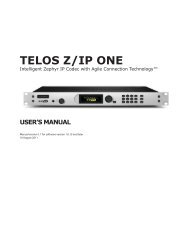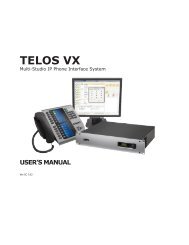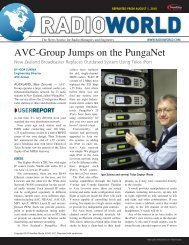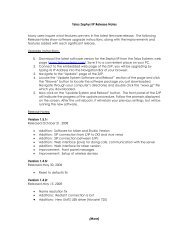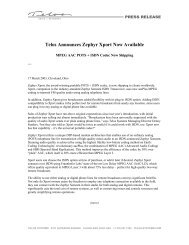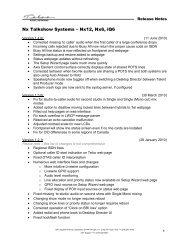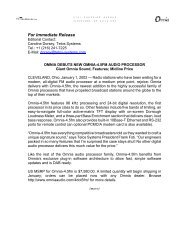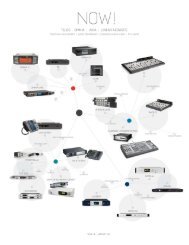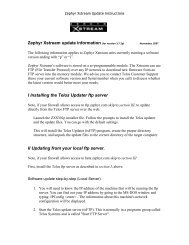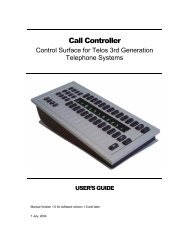Hx1-Hx2 Manual-1.4.1 - Telos
Hx1-Hx2 Manual-1.4.1 - Telos
Hx1-Hx2 Manual-1.4.1 - Telos
You also want an ePaper? Increase the reach of your titles
YUMPU automatically turns print PDFs into web optimized ePapers that Google loves.
A16 | appendix 1<br />
Tie Line- See Tie Trunk.<br />
Tie trunk- A Trunk between two PBXs. Note, a tie line is a dedicated circuit, not a switched<br />
circuit. See Trunk.<br />
TR-008 - See SLC-96.<br />
Trouble Ticket-A Telco “work order” used to track Customer Repairs within the Telco. If you<br />
call someone “inside” the Telco’s repair department, they will need this number to proceed. It<br />
will also be needed whenever you call to check on the status of a repair. Always ask for this<br />
number when initiating a repair request.<br />
Trunk- A communications path between two switching systems. Note that many trunks may<br />
be on a single circuit (if that circuit has multiple channels). The trunks most users will deal with<br />
are between the Telco switch and a PBX. However, a Tie Trunk can connect two PBXs. See also<br />
Tie Trunk and Trunk Group.<br />
Trunk Group- A number of telephone channels which are functionally related. Most common<br />
is the Hunt Group. Other common types include Incoming Trunk Groups and Outgoing Trunk<br />
Groups. See also Combination Trunks and Two-way DID Trunks.<br />
Trunk Side- Central Office: The side of a central office that faces the network, between<br />
switches. Historically many CO switches could not make trunk to trunk connections (as<br />
opposed to tandem and long distance switches, that are always used to connect trunks together).<br />
Hence the need to distinguish between the “line side” and the “trunk side” of the switch. See<br />
also Line Side.<br />
Trunk Side- PBX: The side of a PBX that connects to the Telco. Historically many PBXs could<br />
not make trunk to trunk connections. Hence the need to distinguish between the “line side” and<br />
the “trunk side” of the switch. Since a trunk is a switch-to-switch circuit, these circuits can be<br />
called trunks. Beware, even though you have a PBX, the Telco may still call these “lines” (even<br />
though your PBX considers them trunks). See also Trunk and Line Side.<br />
Two-way DID trunk- An ISDN PRI equipped for direct inward dialing. Most PBX trunks are<br />
related to a given phone number, either alone or as part of a hunt group. In the case of a “normal”<br />
(i.e. analog) DID Trunk, a group of phone numbers are associated with that DID trunk<br />
(or group of trunks) and incoming calls include the DID number, so the PBX can route that<br />
call to the correct DID extension. These are one-way (i.e. inward only) trunks. This is exactly<br />
how ISDN PRI functions, with the DID information coming in over the D channel. There is a<br />
big difference between a normal DID Trunk and a Two-way DID trunk over ISDN PRI. For<br />
one thing, ISDN PRI is digital. Another distinction is that you cannot dial out over a true DID<br />
trunk, while you can dial out over a PRI (hence the conflicting designation “Two Way Direct<br />
Inward Dialing Trunk”).<br />
Two Wire – A circuit path where only a single pair of wires is used. A hybrid is used to convert<br />
from two wire to four wire circuits. No hybrid is perfect, and those used by the phone company<br />
can be poor. However, the hybrids in <strong>Telos</strong> Hx units are approaching perfection!<br />
USOC – Universal Service Order Code, The Bell System Universal Service Ordering Code<br />
(USOC) system was developed to connect customer premises equipment to the public network.<br />
These codes, adopted in part by the FCC, Part 68, Subpart F, Section 68.502, are a series of<br />
Registered Jack (RJ) wiring configurations for telephone jacks that remain in use today. The now<br />
famous RJ-11 and RJ-45 came from this naming convention.<br />
Variant- The particular protocol (i.e. National ISDN-1 or ETS 300) running on a specific<br />
switch. Not all variants are valid for a specific switch. The switch brand and model plus the<br />
variant defines the ISND protocol. Applies to configuring the 2101. See ISDN Protocol.



